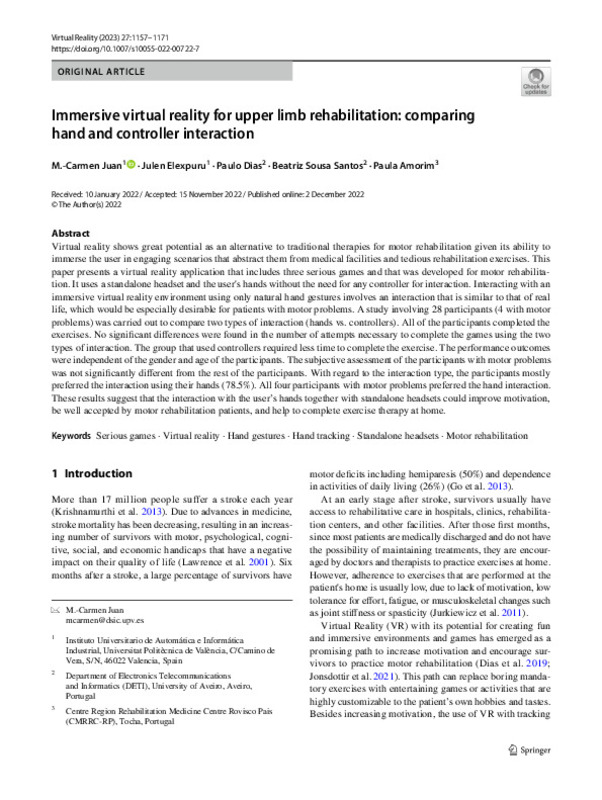JavaScript is disabled for your browser. Some features of this site may not work without it.
Buscar en RiuNet
Listar
Mi cuenta
Estadísticas
Ayuda RiuNet
Admin. UPV
Immersive virtual reality for upper limb rehabilitation: comparing hand and controller interaction
Mostrar el registro sencillo del ítem
Ficheros en el ítem
| dc.contributor.author | Juan, M.-Carmen
|
es_ES |
| dc.contributor.author | Elexpuru, Julen
|
es_ES |
| dc.contributor.author | Dias, Paulo
|
es_ES |
| dc.contributor.author | Sousa Santos, Beatriz
|
es_ES |
| dc.contributor.author | Amorin, Paula
|
es_ES |
| dc.date.accessioned | 2024-04-11T06:28:23Z | |
| dc.date.available | 2024-04-11T06:28:23Z | |
| dc.date.issued | 2023-06 | es_ES |
| dc.identifier.issn | 1359-4338 | es_ES |
| dc.identifier.uri | http://hdl.handle.net/10251/203283 | |
| dc.description.abstract | [EN] Virtual reality shows great potential as an alternative to traditional therapies for motor rehabilitation given its ability to immerse the user in engaging scenarios that abstract them from medical facilities and tedious rehabilitation exercises. This paper presents a virtual reality application that includes three serious games and that was developed for motor rehabilitation. It uses a standalone headset and the user's hands without the need for any controller for interaction. Interacting with an immersive virtual reality environment using only natural hand gestures involves an interaction that is similar to that of real life, which would be especially desirable for patients with motor problems. A study involving 28 participants (4 with motor problems) was carried out to compare two types of interaction (hands vs. controllers). All of the participants completed the exercises. No significant differences were found in the number of attempts necessary to complete the games using the two types of interaction. The group that used controllers required less time to complete the exercise. The performance outcomes were independent of the gender and age of the participants. The subjective assessment of the participants with motor problems was not significantly different from the rest of the participants. With regard to the interaction type, the participants mostly preferred the interaction using their hands (78.5%). All four participants with motor problems preferred the hand interaction. These results suggest that the interaction with the user's hands together with standalone headsets could improve motivation, be well accepted by motor rehabilitation patients, and help to complete exercise therapy at home. | es_ES |
| dc.description.sponsorship | Open Access funding provided thanks to the CRUE-CSIC agreement with Springer Nature. | es_ES |
| dc.language | Inglés | es_ES |
| dc.publisher | Springer-Verlag | es_ES |
| dc.relation.ispartof | Virtual Reality | es_ES |
| dc.rights | Reconocimiento (by) | es_ES |
| dc.subject | Serious games | es_ES |
| dc.subject | Virtual reality | es_ES |
| dc.subject | Hand gestures | es_ES |
| dc.subject | Hand tracking | es_ES |
| dc.subject | Standalone headsets | es_ES |
| dc.subject | Motor rehabilitation | es_ES |
| dc.subject.classification | LENGUAJES Y SISTEMAS INFORMATICOS | es_ES |
| dc.title | Immersive virtual reality for upper limb rehabilitation: comparing hand and controller interaction | es_ES |
| dc.type | Artículo | es_ES |
| dc.identifier.doi | 10.1007/s10055-022-00722-7 | es_ES |
| dc.rights.accessRights | Abierto | es_ES |
| dc.contributor.affiliation | Universitat Politècnica de València. Escuela Técnica Superior de Ingenieros Industriales - Escola Tècnica Superior d'Enginyers Industrials | es_ES |
| dc.description.bibliographicCitation | Juan, M.; Elexpuru, J.; Dias, P.; Sousa Santos, B.; Amorin, P. (2023). Immersive virtual reality for upper limb rehabilitation: comparing hand and controller interaction. Virtual Reality. 27(2):1157-1171. https://doi.org/10.1007/s10055-022-00722-7 | es_ES |
| dc.description.accrualMethod | S | es_ES |
| dc.relation.publisherversion | https://doi.org/10.1007/s10055-022-00722-7 | es_ES |
| dc.description.upvformatpinicio | 1157 | es_ES |
| dc.description.upvformatpfin | 1171 | es_ES |
| dc.type.version | info:eu-repo/semantics/publishedVersion | es_ES |
| dc.description.volume | 27 | es_ES |
| dc.description.issue | 2 | es_ES |
| dc.identifier.pmid | 36475065 | es_ES |
| dc.identifier.pmcid | PMC9715412 | es_ES |
| dc.relation.pasarela | S\500356 | es_ES |
| dc.contributor.funder | Universitat Politècnica de València | es_ES |








